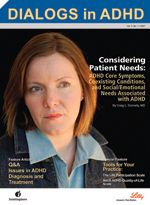Adult ADHD Quality of Life Measure: Development, Description, and Uses
As awareness of adult ADHD has increased, more pharmacological and psychosocial treatments have been developed and tested in adults with this condition.
Purpose of the AAQoL
As awareness of adult ADHD has increased, more pharmacological and psychosocial treatments have been developed and tested in adults with this condition. Consequently, there is a growing need for patient-reported outcome measures developed and validated for use in this population. Thus far, most measures have been designed to assess symptoms rather than the impact of ADHD, and therefore, they do not capture the effects of ADHD on adults’ health-related quality of life (HRQL). HRQL is a broad construct representing the patient’s subjective perception of the impact of health status, including disease and treatment, on physical, psychological, and social functioning.
In adults, ADHD symptoms are associated with impairment in multiple domains that are considered to be key aspects of HRQL, including work performance, social functioning, educational attainment, emotional adjustment, and marital adjustment. Consequently, the Adult ADHD Quality of Life Measure (AAQoL) was recently developed to assess the impact of adult ADHD on HRQL.
Development and Psychometric Validation
The items of the AAQoL were generated based on literature review as well as patient and clinician input indicating that adult ADHD has an impact on functioning in five areas: work, daily activities, relationships, psychological well-being, and physical well-being. In the first validation study conducted with a managed-care sample, four distinct factors were identified through exploratory factor analysis, and the measure was shown to have good internal consistency reliability, construct validity, and discriminant validity. In addition, analysis of clinical trial data has found that the AAQoL is responsive to change in ADHD symptoms. Reliability and validity were also examined in this clinical trial sample, and results were consistent with the initial validation study.
Description
The AAQoL has 29 items designed to assess HRQL during the past two weeks among adults with ADHD.7 Each item is rated by patients on a five-point Likert scale ranging from “Not at all/ Never” (1) to “Extremely/Very Often” (5). The AAQoL yields a total score (based on all 29 items) and four subscale scores:
• Life Productivity (11 items, including getting things done on time, completing projects or tasks, remembering important things, and balancing multiple projects)
• Psychological Health (six items, including feeling anxious, overwhelmed, and fatigued)
• Life Outlook (seven items, including perceptions that energy is well spent, people enjoy spending time with you, you can successfully manage your life, and you are as productive as you would like to be)
• Relationships (five items, including tension, annoyance, and frustration in relationships).
Scoring
Total and subscale scores are computed by (1) reversing scores for all items except the seven items in the Life Outlook subscale; (2) transforming all item scores to a 0-100 point scale (1=0; 2=25; 3=50; 4=75; 5=100); and (3) summing item scores and dividing by the item count to generate subscale and total scores. The scoring algorithm indicates that the total score can be computed with up to three missing items, and each subscale score can be computed with up to one missing item.
Interpretation
Higher scores indicate better HRQL. Exploratory analyses have been conducted to provide an initial suggestion of the Minimally Important Difference (MID) of the AAQoL. MID has been defined as the smallest difference in score which patients would perceive as beneficial. Based on distribution-based statistics commonly used to estimate MID, the MID for the AAQoL subscales and total score is likely to be in the range of 4 to 8 points. Given that anchor-based analyses were not conducted, these estimates should be considered preliminary, and additional analyses are needed to better understand the degree of change that can be considered clinically meaningful.
Use of This Instrument
Given the unique content and strong psychometric properties of the AAQoL, this instrument is likely to be useful in both research and clinical practice. Most clinical trials of treatment for adult ADHD focus on symptom-based outcomes. The AAQoL is a valid and responsive tool that can be used in future trials to provide a broader picture of treatment outcomes. Furthermore, like other quality of life measures, the AAQoL is likely to be useful in clinical practice. Use of these measures can facilitate patient-clinician communication, while helping clinicians better understand the broader effects of disease and treatment on individual patients.
